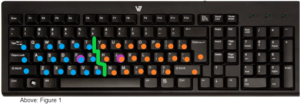Touch Typing Method Isn’t Working? Try Using Adaptive Typing!
By Morgan Kimball
Many individuals with dyslexia like to use some form of speech-to-text typing, or spell checker every day; I know I do. Thanks to assistive technologies like speech-to-text or phonetic spell checkers, it can make writing documents easier. I use these technologies daily at my workplace and in my home life.
Like most of you, you learned how to type on a keyboard using the Touch-Typing method. The touch-typing method is where you use all ten fingers without looking at the keyboard. Just like how I am typing this blog right now. However, this way of typing requires almost as much motor planning and working memory as handwriting does – the two things kids with dyslexia and dysgraphia lack.
Beth King, Ph.D., a neuropsychologist specializing in dysgraphia, recommends that if you choose to use a typing program, do the practices but ignore the keys and hand positioning exercises. King goes on to recommend a simple system called Adaptive Typing.
What is Adaptive Typing?
Adaptive typing is easier to learn and just as functional as touch typing. This is an adapted way to type that can help the specific needs of kids with language-based learning struggles. The goal is to minimize the motor and memory demands of typing. Adaptive typing helps kids to learn a technique that lets them write without much mental energy, so they can use that energy for thoughts and ideas they want to communicate.
Ways Adaptive Typing Works:
- Divide the keyboard into right/left halves using markers, tape, stickers, etc.
- It’s okay to look at the keyboard.
- Use index fingers for typing and thumbs for the space bar. The left hand does the left side, and the right hand does the right.
How to Set Up Adaptive Typing?
Using a marker or tape, divide the keyboard vertically in half. In between the T and Y, the G and H, and the V and B if your child is right-handed, or the B and the N if your child is left-handed. Mark F and J with a sticker or a marker. (Look at Figure 1).
Please have your child type, looking at the keyboard, using only their index fingers and thumbs. If your child is having trouble with the left and the right side (like most dyslexics do), you can get two different colors of small stickers to mark the left and right-side keys. Be sure to write the letters on top of the stickers. You don’t want your child to rely on memory.
Typing Programs That Work with Dyslexia and Dysgraphia:
Don’t be afraid to modify the typing programs you use. Here are some of the highly recommended programs for those with dyslexia and dysgraphia:
- Touch Type Read Spell (TTRS)
- Typing.com
- Dancemat Typing
- TypingClub.com
- Nessy Fingers
